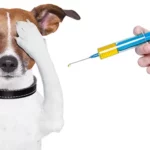
This article covers information on important health studies on dogs that is too often missing from vet advice.
As I am not a veterinarian, I am not permitted to give medical advice regarding canine health. I am not going to. So, what will I write about then, you may wonder? I will share publicly available information published by the National Institute of Health and other reputable and well-respected veterinary scientists.
The National Institutes of Health (NIH), a part of the U.S. Department of Health and Human Services, is the nation’s medical research agency. It doesn’t get more official than that. Every dog owner should know about the studies I am going to share. Their findings indicate that some things we have become accustomed to doing to our dogs are ill-advised and need a fresh look. We will also review some of my personal decisions and opinions I formed based on this information.
I am a certified professional dog trainer and own several dogs. In addition, I have seen the health journeys of many client dogs during my time in the business. I also regularly read canine medical studies, so I have adopted strong opinions on what I consider healthy and unhealthy for dogs. My German Shepherd Max lived to be nineteen years old, and my boy Sylvester, also a German Shepherd, lived to be seventeen. It would appear I am doing something right, as all my dogs are healthy and rarely need to see my veterinarian.
Appreciate Vets Advice
This article is not intended as a criticism of veterinarians. I value vet advice in many areas. Most veterinarians are well-intentioned, good people, and some black sheep exist in any profession. We all need great veterinarians we can rely on in case of need, and I love my veterinarians. I use several different ones for different reasons, and I will touch on those later. My veterinarians have saved my own dog’s lives after accidents and other medical emergencies over the years. I am grateful for their skill and expertise and appreciate vet advice in all medical areas.
We call all appreciate that if you are a busy veterinarian, it is often difficult to stay up-to-date on the latest research in every area of veterinary care, no matter how much one tries or wants to. I acknowledge that my veterinarian can’t know everything.
Veterinarians know a lot about animal health, how to diagnose diseases, perform surgeries, etc. It is what they learned in veterinary school. It takes a while to get through that, so always listen to vet advice on these matters. We need to appreciate their expertise in their field. But we also need to acknowledge what is limited or missing in the typical veterinary school curriculum. I.e., most veterinarians can perform spay or neuter surgeries, but what if you don’t want to remove the entire reproductive system because it impacts the endocrine system? That has health impacts, especially later in your dog’s life. What if you want a vasectomy or ovarian-sparing spay for your dog? Usually, only a board-certified veterinary surgeon knows how to perform those, and most veterinarians will easily admit they can’t perform that surgery, as they didn’t learn how to.
Know When Vet Advice May Be Limited
However, many veterinarians don’t seem to feel the same restraint when assessing or evaluating canine nutrition or dog food, which receives little attention in standard veterinary training. This is why we have experts in that field, called canine nutritionists. Veterinarians should be open about not being experts on canine nutrition unless they have supplemental education. They should refer you to a specialist instead of suggesting food brands they sell themselves. Sometimes vet advice requires greater scrutiny.
I feel similarly about the far too frequent, instant prescription of anti-anxiety medication for fearful dogs. Anxiety and fear in dogs is a field I specialize in. Veterinarians aren’t behavioral experts and usually don’t have enough understanding of canine behavior to prescribe the best possible solution for an anxious dog. I am not saying it could never include a prescription, but if that is all one has to offer, the answer to every behavior challenge becomes a pill. This is basically what veterinary behaviorists do; they prescribe drugs. Take any vet advice on behavioral treatments with a grain of salt. It’s not their field of expertise.
Honesty is the Best Policy
We should all be open and honest about what our area of expertise is and stick to that or if we wander outside of it, offer solid evidence for our opinions, like I am doing in this article. An opinion not rooted in reality and fact—to me—is the most useless thing in the world.
This is what I will do. I will touch on several areas of canine health, provide the relevant published studies regarding current standard practices and share my approach in each area. I am not calling on anyone to follow my lead, but I encourage you to review this information. Review your current practices regarding your dog. Maybe discuss this with your current veterinarian. And maybe have a second conversation with a holistic veterinarian to see the difference. Listening to different vet advice can be eye-opening. You may hear very different perspectives. Your dog will thank you.
… My Dog Needs to be Vaccinated / Needs Annual Booster Shots
Yes, your dogs need to be vaccinated against things that can kill them. In most states, you must get a rabies vaccine every three years. Efforts are underway to change the interval to five years and even seven years by the Rabies Challenge Fund Study (PDF). Dr. Ronald Schultz and Dr. Jean Dodds, two highly respected vaccination experts, published their 2020 findings on vaccine durations and immunizations. I highly recommend you take a look.
No other vaccine is mandated by law, but Parvo and Distemper are also considered core vaccines and should be administered. Some also consider Hepatitis a core vaccine, but Dr. Dodds disagrees, and she is the expert. However, I don’t blindly re-vaccinate my dogs with these vaccines annually. Vaccinations carry risks. I only get a booster shot when the immunity from the last vaccination is wearing off.
Understanding Vaccines and Immunity
Based on studies, most canine vaccines last between five years and the life of your dog! Studies consistently show that most vaccines only need to be given once for lifetime protection. Has local vet advice on vaccinations included this information? Luckily, more and more veterinarians (especially holistic veterinarians) can now perform affordable titer tests in-house. I found a great local veterinarian who makes this easy and affordable. Titer tests confirm if your dog has immunity (PDF) (antibodies in the blood) or needs a new vaccination. Like every medical procedure, vaccines have risks, and there can always be adverse reactions.
I don’t give my dogs any other vaccines besides the core shots. The diseases, addressed by all the other vaccines, are either easily treatable, should they occur, or are rare. If a veterinarian—especially the ones in veterinary hospital chains are known for this—recommends vaccines against diseases other than the core vaccines, it is always a good idea to spend a few minutes researching how many cases of this disease were reported in the prior year in the country overall and your state in particular. The fewer the cases, the lower the risk, and I would never accept a vaccine for a disease with only a few cases in my state unless the disease is fatal.
Remember that most boarding and grooming places require your dog to get a Bordetella vaccine (basically your dog’s flu shot), some every six months! This is irresponsible, in my view. This is one of the reasons I groom my dogs myself and have a great pet sitter who comes to my home when necessary. I am not doing that to my dogs.
Listen to the Experts
Dr. Ronald D. Schultz is the Professor and Chair of the Department of Patho-Biological Sciences at the School of Veterinary Medicine at the University of Wisconsin-Madison.
Dr. Jean Dodds, DVM, was a research scientist with the New York State Health Department and Executive Director of the New York State Council on Human Blood and Transfusion Services. She is also the founder of Hemopet (thyroid blood tests and canine blood bank) and Nutriscan (saliva food allergy tests). I frequently listen to this vet advice.
In short, these two experts know what they are talking about.
Links to the Studies
- Duration of Immunity to Canine Vaccines (PDF) by Dr. Ronald D. Schultz, published by the School of Veterinary Medicine, University of Wisconsin-Madison, 1998
- Duration of Immunity for Canine and Feline Vaccines (PDF) by Dr. Ronald D. Schultz, published in Veterinary Microbiology, October 2006, Vol. 117, Issue 1, Pages 75-79
- 2017 AAHA Canine Vaccination Guidelines (PDF) by Dr. Ronald D. Schultz, published by the American Animal Hospital Association (AAHA), October 2017
- 2018 Vaccine Protocol and Best Practices (PDF) by Jean Dodds, DVM, published in Israel Journal of Veterinary Medicine, June 2018, Vol. 73, Issue 2, Pages 3-10
- Changing Vaccine Protocols (PDF) by Jean Dodds, DVM, published by Hemopet, October 2012
- Vaccine Adverse Events in Dogs (PDF) by Aguirre et al., published in the Journal of the American Veterinary Medical Association, October 2007, Issue 231, Pages 79-88
- Rabies Challenge Fund (PDF) by Jean Dodds, DVM, and Dr. Ronald D. Schultz, published in the Canadian Journal of Veterinary Research, April 2020, Vol. 84, Issue 2, Pages 153–158
… My Dog Needs Tick and Flea Control
That sounds like a good idea. I suggest you take active measures to prevent ticks and fleas from infesting your dog. However, how you go about it matters. Several studies from as far back as 1989 have shown that the tick and flea drops applied to your dog’s back pose a measurable risk of cancer, transitional cell carcinoma, and bladder cancer. The tick and flea collars aren’t any better. These products work in terms of preventing ticks and fleas but at what cost?
These products contain poisonous insecticides and herbicides. Similar chemicals are used for bug prevention on lawns and in gardens. They are as toxic and pose as much of a cancer risk as garden products. All of these have been shown in many studies to cause cancer in animals and humans. Applying that to a dog’s back doesn’t seem like the greatest of ideas. Why are you being told not to let your dog sleep in bed with you after a tick and flea drop was applied? Because it’s toxic and harmful to humans too. Did vet advice you received on pest control cover this information?
For seventeen years, I have used natural alternatives to prevent ticks and fleas with my dogs and have never had a tick or flea problem. Here are a few suggestions.
Natural Alternatives
Garlic: What? Isn’t that poisonous? No, not in small dosages. Too much garlic is toxic, no doubt, but too much of anything is harmful. People have died from drinking too much water. I use two teaspoons of organic garlic powder for an 80-lb dog per week. When I prepare raw food for my dogs once a week, I distribute it evenly during food preparation. If you’re feeding differently, you could set two teaspoons of garlic powder aside in a shot glass each week and sprinkle some over the food each feeding. Wet dry food with a spray bottle (water only) before sprinkling the garlic so that it will stick to the kibble.
A veterinarian once challenged me on that approach, telling me there was a study proving garlic doesn’t work for flea prevention. When I asked for a copy of that study, she couldn’t produce it and revealed the study proved garlic doesn’t kill fleas or ticks. That is correct. Garlic doesn’t kill fleas or ticks, but it repels them, meaning they leave my dogs alone, and that is all that matters. What is this obsession with killing things? This vet advice was more of a biased opinion than fact. She misrepresented the studied science.
Essential Oils: Another approach is making yourself an essential oil spray. Use a small spray bottle, fill it 2/3 with purified water or organic witch hazel and add 10-15 drops of essential oils of d-limonene (use a combo of lemon, orange, and grapefruit), rosemary, and lavender each. Spray your dog with it a few times a week.
Dr. Judy Morgan has more ideas on natural tick and flea prevention without toxins.
Links to the Studies
- Epidemiologic Study of Insecticide Exposure, Obesity, and Risk of Bladder Cancer in Household Dogs by Glickman et al., published in Journal of Toxicology and Environmental Health, 1989, Volume 28, Issue 4, Pages 407-414
- Herbicide Exposure and the Risk of Transitional Cell Carcinoma of the Urinary Bladder in Scottish Terriers (PDF) by Glickman et al., published in the Journal of the American Veterinary Medical Association, April 2004, Volume 224, Issue 8, Pages 1290-1297
- Epidemiologic Studies of Risk Factors for Cancer in Pet Dogs (PDF) by Kelsey et al., published in Epidemiologic Reviews, 1998, Volume 20, Issue 2, Pages 204-217
- Polluted Pets: Chemical Exposures and Pets’ Health published by the Environmental Working Group (EWG), April 2008
… My Dog Needs Parasite / Worm Protection
Yes, they do, but it depends on how you go about it. Typical ingredients in the most common preventative treatments include Ivermectin and Afoxolaner. While there are certainly worse things on this earth, these chemicals have side effects. Just look at your current product, google its ingredients and side effects and decide if those are something you want to expose your dog to. I certainly don’t. I’m not a big fan of anything that isn’t necessary.
I have used Noni Fruit Leather as a parasite preventative for over ten years, and I even dealt with a whipworm infection in my rescue dog Max when he joined the family. He came to me with this infestation, and I didn’t know he was ill. Neither did the shelter, as he had no symptoms. I detailed my whipworm story in my article “Treating Whipworms in Dogs Naturally.” Noni Fruit Leather has been working well for me, and none of my dogs have ever contracted any parasites. Not even my existing dogs got sick when Max joined us. Whipworms are nasty little things that can survive in the soil for seven years. Noni is the standard vet advice on parasite prevention in Hawaii; in the continental United States, not so much.
Another way of preventing parasites is food-grade Diatomaceous Earth. A product that makes administering it easy is Paratrex. It is a parasite treatment and preventative for humans you can also use for dogs.
Links to the Studies
- Morinda Citrifolia (Noni) Linn. Reduces Parasite Load (PDF) by Almeida-Souza et al., published in PLOS Neglected Tropical Diseases, August 2016, Volume 10, Issue 8
- Epidemiologic Studies of Risk Factors for Cancer in Pet Dogs (PDF) by Kelsey et al., published in Epidemiologic Reviews, 1998, Volume 20, Issue 2, Pages 204-217
- Epidemiologic Study of Insecticide Exposure, Obesity, and Risk of Bladder Cancer in Household Dogs by Glickman et al., published in Journal of Toxicology and Environmental Health, 1989, Volume 28, Issue 4, Pages 407-414
… My Dog Must be Spayed/Neutered
The answer to this question is far more complicated than you might think. Strictly looking at the research data from the last few years, in terms of a dog’s health, the answer seems to be become a clearer ‘no’ by the day. But there are many other factors to consider besides biological health. An unsterilized dog can’t go to most dog parks, often can’t join daycares or dog walkers, and will have to miss out on other adventures. That can be psychologically unhealthy for your dog and lead to behavioral issues. Spaying or neutering—especially when done too early in life—will most likely affect your dog’s physical health and shorten its life span.
In addition, intact dogs often lead to accidental litters, which adds to pet overpopulation and increases euthanasia rates in shelters across the country. I wrote a more comprehensive article on this topic, which you can find here: My Thoughts on Spaying and Neutering. Some of the key findings from recent studies include:
A study published at UC Davis in 2013, titled “Long-Term Health Effects of Neutering Dogs: Comparison of Labrador Retrievers with Golden Retrievers” found that sterilization of Golden Retrievers before six months of age increases their risk of joint diseases later in life by 400% to 500% percent! Similarly, for Labrador Retrievers and German Shepherds (separate UC Davis study in 2015) by 300%. These are alarming risk factors.
For female Golden Retrievers, spaying at any point after six months has even more serious consequences. The cancer risk increased by 300% to 400% percent. For female Labrador Retrievers, the cancer risk increased only slightly. Similar results were found in German Shepherds in a 2015 UC Davis study. There is also a medium to high risk of urinary tract infections and incontinence for females.
These Studies Changed My Mind
My personal view on spaying and neutering has changed over the years. All my rescue dogs were spayed and neutered by the shelter. I would have preferred forgoing those procedures and instead having the option of a vasectomy (for males) or an ovarian-sparing spay (for females). These procedures achieve the desired sterility without impacting the endocrine system of the dogs and, as such, avoid the health risks the studies outline. However, only board-certified veterinarians know how to perform those procedures, and they are also more expensive than the common spay and neuter surgeries. I wrote more on this, including information on locating a qualified veterinarian in my spay and neuter article.
Links to the Studies
- Epidemiologic Studies of Risk Factors for Cancer in Pet Dogs (PDF) by Kelsey et al., published in Epidemiologic Reviews, 1998, Volume 20, Issue 2, Pages 204-217
- Early Neutering Poses Health Risks for German Shepherd Dogs, Study Finds (UC Davis, 2016) (PDF)
- Neutering Dogs: Effects on Joint Disorders and Cancers in Golden Retrievers (UC Davis, 2013) (PDF)
- Long-Term Health Effects of Neutering Dogs: Comparison of Labrador Retrievers with Golden Retrievers (UC Davis, 2014) (PDF)
… My Dog Should Eat Food XYZ
Food has become my biggest concern for dog health. I feed my dogs a breed-specific, raw diet. But I understand not everyone is comfortable with that. There are also many rabbit holes I could dive into on this topic, but I will keep this to three basic dog food facts.
Vet Advice on Dog Food
First, ask many questions if your veterinarian suggests a specific food brand they sell. If your veterinarian is not also a trained canine nutritionist, their opinion is likely not informed on that topic. Canine nutrition is a complex field and is not included in veterinary school in any meaningful way. Get nutrition advice from someone with the right background. Your veterinarian may advise you need dog food with more or less protein or fat to support a health concern. That is fair, but I recommend you find that food yourself or work with a trained canine nutritionist to formulate it. I also question food recommendations for weight management. Simply reducing the portion size of your dog food and cutting out all treats seems easier to help your dog lose weight.
Understanding Dog Food Ingredients
Second, while the FDA regulates human food ingredients, there are fewer controls on pet foods. Understanding some labels and nutrition basics helps. Like with human food, the first three ingredients listed on the pet food label make up most of what is in the bag. Those should be meat-based protein sources or, at the very least, meals with meat-based protein sources.
If the ingredient list starts with chicken by-product meal (not the good parts), brown rice, corn, or brewer’s yeast, you are on the wrong track. Also, don’t be fooled by grain-free foods. They include starches like potatoes, corn, tapioca, wheat, peas, or oatmeal. They don’t make the food better. A good food ingredient list starts with these: beef, wild boar, goat, lamb, lamb liver, beef liver, beef tripe, wild boar liver, mutton, beef heart, whole Atlantic mackerel, and pork. These are the first twelve ingredients of what I consider the best dry dog food you can buy: Orijen Regional Red. I use Orijen on hikes with my dogs when bringing raw food is not feasible.
Keep Carbohydrates Low
Third, keeping carbohydrates low is another factor in selecting or formulating good dog food. Dogs can certainly process carbohydrates but don’t need much, if any, for a healthy diet. A natural dog diet consists mostly of fat, protein, and only a few carbohydrates. Complex carbohydrates (found in foods such as peas, beans, whole grains, and vegetables), as well as simple carbohydrates (found in fruits and milk products), are all converted to glucose (blood sugar) in the body. Carbohydrates become sugar upon digestion.
However, looking at the dog food label to find out how much carbs/sugar is in that bag is a fruitless exercise. The dog food manufacturers have good lobbyists and don’t have to list that information on the bag. But they must list the other relevant ingredients, so the math is simple. Look for the percentage of fat, protein, moisture, and ash (estimate at 6% if not listed). Add those numbers and subtract them from 100 to arrive at the percent of carbs/sugar in your dog food bag. The lower the carbohydrate percentage, the better. Here are a few examples of well-known, popular dog food brands. The percentage values below are taken from the respective labels.
Dog Food Review (Select Examples)
- Purina Beneful Healthy Weight with Real Chicken:
100% – 25% (protein) – 8% (fat) – 14% (moisture) – 6% (ash) = 47% carbs - Blue Buffalo Wilderness Rocky Mountain Recipe with Red Meat Adult Grain-Free:
100% – 24% (protein) – 14% (fat) – 10% (moisture) – 6% (ash) = 46% carbs - Hill’s Science Diet Adult Perfect Weight:
100% – 24% (protein) – 9.5% (fat) – 10% (moisture) – 6% (ash) = 50.5% carbs - Orijen Regional Red:
100% – 38% (protein) – 18% (fat) – 12% (moisture) – 6% (ash) = 26% carbs
As this short sample shows, there is a lot of sugar in many dog foods, even those sold for weight management. This example also highlights why I consider Orijen a great food as far as kibble goes.
… My Dog Needs Anti-Anxiety Medication
Based on my experience, in most cases, I believe the answer to that question to be “no.” As I mentioned in the introduction, I am a professional dog trainer specializing in helping fearful and anxious dogs gain more confidence and overcome their fear. In the last couple of years, veterinary behaviorists have ventured into the pet world, offering drug-based solutions to anxiety. They are the psychiatry arm of the veterinary world. Some veterinary behaviorists have a solid education and understand behavior more comprehensively, but that is the exception. The knowledge of many veterinary behaviorists is mostly theoretical. They don’t interact with dogs much and often lack an understanding of ethology and evolutionary psychology. Without regular interaction and a comprehensive understanding, it is impossible to know what is typical behavior and what is not. For this reason, I consider this drug prescription focus irresponsible.
Further, whether these drugs do much besides dulling the dog’s senses is unclear. Drugs can give the outward illusion that the dog is “better” because it is calmer. But the moment you stop the drugs, the dog returns to where it was. Psychopharmaceuticals are life-long management. They don’t heal or change a dog. In addition, we have no idea what the long-term effects are either. The following two studies are food for thought.
The Effectiveness of Psychopharmaceuticals is Questionable
The study “Selective Publication of Antidepressant Trials and Its Influence on Apparent Efficacy” published in The New England Journal of Medicine in 2008, examined 74 FDA-registered studies for a dozen antidepressants and found that most studies with negative results were not published in the scientific literature or were published in a way that conveyed a positive outcome. This finding raises the question of what evidence we truly have for the efficacy of antidepressant drugs.
Another study, “Effectiveness of Antidepressant: An Evidence Myth Constructed from a Thousand Randomized Trials?” published in Philosophy, Ethics and Humanities in Medicine also in 2008, suggests that “…antidepressants may be less effective than their wide marketing suggests. Short-term benefits are small and long-term balance of benefits and harms is understudied…”.
It is tempting to use the promise of a quick fix with medication. In contrast, helping a dog overcome its fear is a long process and requires patience. I don’t work with dogs on anti-anxiety medication and advise people to discuss with their veterinarians how to get them off those drugs first if they want to work with me. I don’t mind using natural calming products like valerian root or CBD/THC oils for a short period. Those wear off quickly, and training progress can be assessed easily. But for as long as a dog is on anti-anxiety medication, meaningful, lasting behavioral change is not feasible in my experience. I know some trainers disagree with my last statement.
If your dog has anxiety, I recommend finding an experienced dog trainer and resolving the underlying problem. If you have given it your all, and it didn’t work, you can still try drugs for lifetime management afterward. But I would not start there. If vet advice you receive on anxiety is drugs as the first step, more research is in order.
Links to the Studies
- Effectiveness of Antidepressant: An Evidence Myth Constructed from a Thousand Randomized Trials? (PDF) by Loannidis, published in Philosophy, Ethics and Humanities in Medicine, May 2008, Volume 3, Issue 14
- Selective Publication of Antidepressant Trials and Its Influence on Apparent Efficacy (PDF) by Turner et al., published in The New England Journal of Medicine, January 2008, Volume 358, Issue 3, Pages 252-260
… My Dog Needs Allergy Shots
Maybe. That really depends on the types of allergies your dog has. My personal view is that you should investigate what kind of allergies your dog has first, before using allergy shots or steroids trying to manage something you don’t fully understand. But the first rule in medicine is, to stop the bleeding. If you must get a serious infection under control, you must do what makes the most sense immediately. Let your veterinarian guide you on how to best deal with any sores or wounds possibly caused by allergies.
I had to give my dog Sylvester steroids once to deal with a nasty infection driven by allergies; I didn’t know he had—for two weeks, not months or years. But long-term, a more methodical approach seems better for your dog’s health. I always want to understand it fully before choosing a treatment approach. Too often, I hear the default comment, “just change the food.” Change it to what? That is a silly suggestion if you don’t know what your dog is allergic to.
Allergy Tests
I started with a comprehensive food allergy test. I like NutriScan.org. This is a comprehensive saliva-based food allergy test. You will find out what food ingredients your dog is allergic to and can then make an informed food change. Suppose it turns out that your dog is not allergic to anything in its food. In that case, I will perform an environmental allergy test with your veterinarian to identify what in your environment is causing the issue. It may be removable. It might not be. But now you know for sure what you are dealing with.
If you learned your dog is allergic to something you can’t change (i.e., dust mites), over-the-counter, generic allergy medication is your cheapest bet for long-term management. Discuss this with your veterinarian. Most human antihistamines can also be given to dogs in the correct dosage. Your veterinarian should be able to advise you. If all of this fails, I would consider regular allergy shots for my dogs.
That’s it. I hope you found some of my own canine health choices worth reviewing, and I hope I gave you some food for thought when evaluating vet advice. Also, check out our podcast episode Allergies in Dogs for more advice and details.
This article was also published on 4Knines.com What Did My Vet Say? Dog Health Information.
Play the Audio







